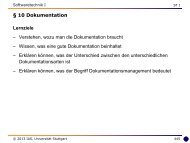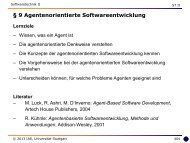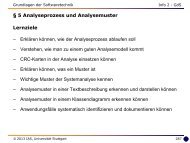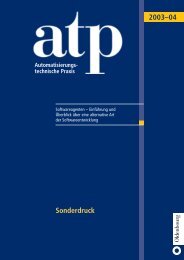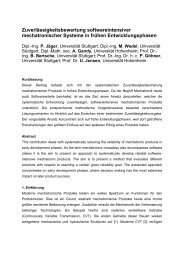Grundlagen FlexRay - Institut für Automatisierungs- und ...
Grundlagen FlexRay - Institut für Automatisierungs- und ...
Grundlagen FlexRay - Institut für Automatisierungs- und ...
You also want an ePaper? Increase the reach of your titles
YUMPU automatically turns print PDFs into web optimized ePapers that Google loves.
<strong>Gr<strong>und</strong>lagen</strong> <strong>FlexRay</strong> BasicsV 1.1 38<br />
2.14 Scheduling and Cycle Multiplexing<br />
The scheduling is defined during the network design. By defining static and dynamic slots, a<br />
fixed time frame is provided. This enables the unique assignment of frames to the<br />
corresponding slots in each channel.<br />
The number of slots is constant and cannot be changed after the network design. The<br />
flexibility and the usage of the bandwidth is defined during development.<br />
Table 2.4 Scheduling example [VeSc11]<br />
In Table 2.4, a scheduling for nodes K, L, M, N and O is provided. It is allowed to send<br />
different frames in different cycles for the same slot. This is called Cycle Multiplexing.<br />
For Cycle Multiplexing, the following information is needed:<br />
• Slot-ID in the cycle 0...2047<br />
• Base or Start Cycle 0...63<br />
• Repetition Factor {rep = 2 x with 0 ≤ x ≤ 7}<br />
• Channel {A, B, A&B}<br />
• Name of the node<br />
If we take a look on node M in Table 2.4, we can see that it is assigned slots 2 and 7. In the<br />
static segment, node M uses channel A only. Here, it sends three different frames, e.g. frame<br />
y, which has a base cycle of 2 and a repetition factor of 4. That means, that frame y is sent in<br />
cycle 2 for the first time, and after that every 2+4n (with n = 1..15) cycle.<br />
In the dynamic segment, it is acceptable for different nodes to use the same slot. Further, the<br />
nodes are allowed to send different frames, and different nodes may use the different channels<br />
of a slot. Again, all frames have to provide the information needed for Cycle Multiplexing.<br />
If we take a look at slot 7, we can see that node M shares this slot with nodes L and O. In a<br />
cycle, it is possible to send different frames from different nodes. It is also possible for<br />
Channels A and B to be asynchronous, i.e. for a given point of time, A has a different slot id<br />
than B.<br />
Bäurle 12.10.2012




